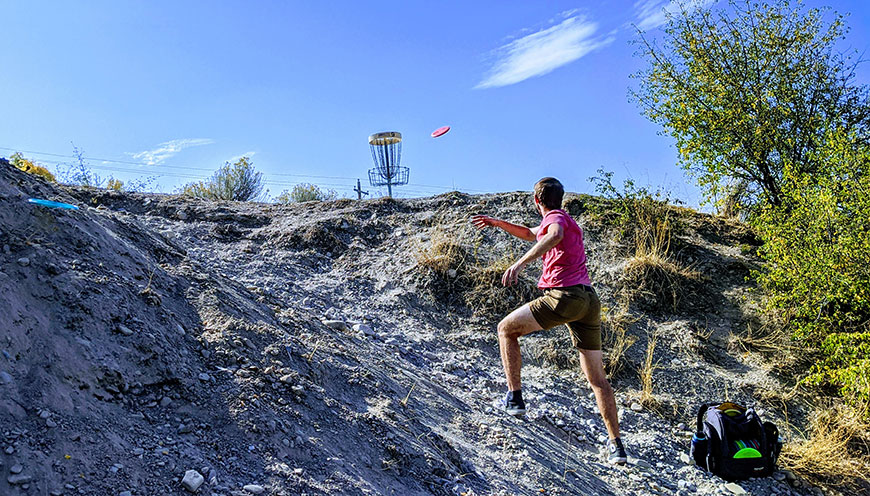Disc golf is a fun sport for everyone. But if you are a newbie, the first thing to learn is the different types of throws in disc golf. These basic throws come with different components and aspects that every beginner must be familiarized with.
This article will highlight these different types of disc golf throws and all the information related to each one. The article will also include the basic technique and other tips when performing these throws on the course.
The Backhand
This type of throw is comparable to a tennis shot with a similar name. The reason behind it is that the backhand throw has a similar movement motion where the arms will cross at the front of the player’s body while moving to the outside and releasing the arms extended before the body.
In a backhand throw, the throwing arm will reach from the back towards the opposite side and swing the body while releasing the disc from the grip at the end of the arm swing motion. If you are new, please remember that the ideal grip is cupping the disc from the outside across from the body.
Then, you must use your thumb at the top and your fingers below the disc where the index finger should be farthest from the ridge. It is also better to use a foot-forward stance when doing a backhand throw. Keeping your feet in proper alignment is essential when doing the throw.
As added information, with so many people using backhand throws, most of the disc golf courses are designed in such a way that it fits backhand throwers. Most players will use the backhand throw starting from the tee to provide maximum distance and control of release.
The Forehand
The forehand throw is considered the second most used throw in disc golf. Also known as the side arm throw, it is the opposite of the backhand throw. The other difference is that the forehand is much more difficult to learn compared to the backhand throw.
In this type of throw, the player’s grip is the same as the backhand. However, rather than curling the wrist inward, the wrist must be turned the opposite. A right-handed disc golfer can extend his right hand behind the shoulder line, levelling the chest. Then, the player will twist slightly to generate some power.
For all beginners, the key is to develop both backhand and forehand throws to help improve your game. This throw is challenging to develop, but having a serviceable forehand will allow you to have another option with your shot.

The Overhand
This type of throw is not always used much during the game. The best time to use an overhand throw is during game situations where you do not have any options. Situations where the disc is deep in the woods, or you do not have any angle to navigate the obstacles in front, is the best time to use overhand throws.
The grip used with an overhand throw is similar to that of the forehand. The only difference is the toss, as it offers a unique flight pattern that will allow the player to get over or around obstacles.
A good example is when you are standing on the opposite side of your target with an obstacle in between. You will toss the disc over the obstacle while making sure that the disc flattens out correctly while navigating the obstacle with the overhand throw.
You need to learn two types of overhand throws: the thumber and the tomahawk. The tomahawk is where the motion resembles the throwing of a tomahawk. The thumber is completely the opposite of the tomahawk throw.
The Hyzer
The hyzer is a type of disc golf throw where the top of the disc is angled to the player. When you are a right-hander that uses the backhand throw, the disc angles of flight will turn to the left. In addition, this type of throw can be used to take advantage of the natural angle of the disc.
In this type of throw, it is essential to understand the natural angle of the disc. Doing this action will allow the player to plan for the next angle when you are dealing with obstacles such as a tree. You can use the hyzer to angle the disc further down to make an angle turn.
The Anhyzer
The anhyzer throw is exactly the opposite of the hyzer throw. So, when you are a right-handed golfer, you will angle the disc to the left, going to the left side of the disc. After you release the disc, it will move to the right, which is the opposite of the natural angle of the disc.
Roller Shots
This type of throw is best used when opening wide-open drives. When it comes to the roller, the key is to throw an understandable disc with enough force and angle for it to land on the disc’s side while rolling down the fairway.
It can be challenging to throw a roller since you need excellent angle control when released. If you fail to do so, the disc will just slow down and ten turns, failing to reach the expected maximum distance.
Conclusion
This article discussed the different types of disc golf throws that every beginner must learn. Each of these throws must be correctly understood for you to practice the more advanced throws in disc golf. The key is to familiarize yourself first with the basic throws before learning the more advanced throw of the sport.

